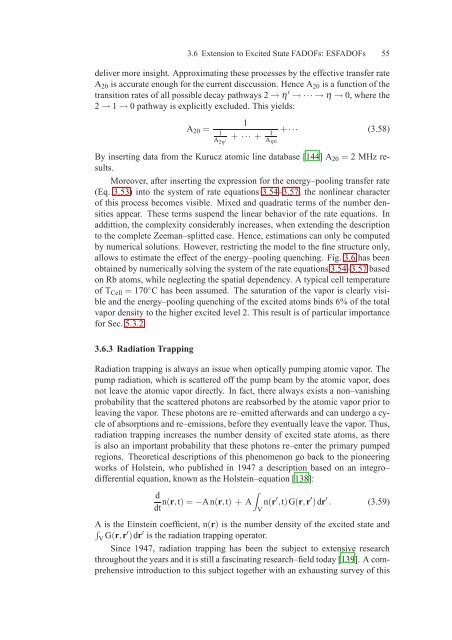Assessment of a Rubidium ESFADOF Edge-Filter as ... - tuprints
Assessment of a Rubidium ESFADOF Edge-Filter as ... - tuprints
Assessment of a Rubidium ESFADOF Edge-Filter as ... - tuprints
You also want an ePaper? Increase the reach of your titles
YUMPU automatically turns print PDFs into web optimized ePapers that Google loves.
3.6 Extension to Excited State FADOFs: <strong>ESFADOF</strong>s 55<br />
deliver more insight. Approximating these processes by the effective transfer rate<br />
A 20 is accurate enough for the current disccussion. Hence A 20 is a function <strong>of</strong> the<br />
transition rates <strong>of</strong> all possible decay pathways 2 → η ′ → ··· → η → 0, where the<br />
2 → 1 → 0 pathway is explicitly excluded. This yields:<br />
1<br />
A 20 =<br />
1<br />
A<br />
+ ··· + 1 + ··· (3.58)<br />
2η<br />
′ A η0<br />
By inserting data from the Kurucz atomic line datab<strong>as</strong>e [144] A 20 = 2 MHz results.<br />
Moreover, after inserting the expression for the energy–pooling transfer rate<br />
(Eq. 3.53) into the system <strong>of</strong> rate equations 3.54–3.57, the nonlinear character<br />
<strong>of</strong> this process becomes visible. Mixed and quadratic terms <strong>of</strong> the number densities<br />
appear. These terms suspend the linear behavior <strong>of</strong> the rate equations. In<br />
addittion, the complexity considerably incre<strong>as</strong>es, when extending the description<br />
to the complete Zeeman–splitted c<strong>as</strong>e. Hence, estimations can only be computed<br />
by numerical solutions. However, restricting the model to the fine structure only,<br />
allows to estimate the effect <strong>of</strong> the energy–pooling quenching. Fig. 3.6 h<strong>as</strong> been<br />
obtained by numerically solving the system <strong>of</strong> the rate equations 3.54–3.57 b<strong>as</strong>ed<br />
on Rb atoms, while neglecting the spatial dependency. A typical cell temperature<br />
<strong>of</strong> T Cell = 170 ◦ C h<strong>as</strong> been <strong>as</strong>sumed. The saturation <strong>of</strong> the vapor is clearly visible<br />
and the energy–pooling quenching <strong>of</strong> the excited atoms binds 6% <strong>of</strong> the total<br />
vapor density to the higher excited level 2. This result is <strong>of</strong> particular importance<br />
for Sec. 5.3.2.<br />
3.6.3 Radiation Trapping<br />
Radiation trapping is always an issue when optically pumping atomic vapor. The<br />
pump radiation, which is scattered <strong>of</strong>f the pump beam by the atomic vapor, does<br />
not leave the atomic vapor directly. In fact, there always exists a non–vanishing<br />
probability that the scattered photons are reabsorbed by the atomic vapor prior to<br />
leaving the vapor. These photons are re–emitted afterwards and can undergo a cycle<br />
<strong>of</strong> absorptions and re–emissions, before they eventually leave the vapor. Thus,<br />
radiation trapping incre<strong>as</strong>es the number density <strong>of</strong> excited state atoms, <strong>as</strong> there<br />
is also an important probability that these photons re–enter the primary pumped<br />
regions. Theoretical descriptions <strong>of</strong> this phenomenon go back to the pioneering<br />
works <strong>of</strong> Holstein, who published in 1947 a description b<strong>as</strong>ed on an integro–<br />
differential equation, known <strong>as</strong> the Holstein–equation [138]:<br />
d<br />
dt<br />
∫V<br />
n(r,t) = −An(r,t) + A n(r ′ ,t)G(r,r ′ )dr ′ . (3.59)<br />
A is the Einstein coefficient, n(r) is the number density <strong>of</strong> the excited state and<br />
∫<br />
V G(r,r′ )dr ′ is the radiation trapping operator.<br />
Since 1947, radiation trapping h<strong>as</strong> been the subject to extensive research<br />
throughout the years and it is still a f<strong>as</strong>cinating research–field today [139]. A comprehensive<br />
introduction to this subject together with an exhausting survey <strong>of</strong> this
















